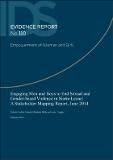| dc.identifier.citation | Nesbitt-Ahmed, Z.; Mills, E. and Diggins, J. (2015) Engaging Men and Boys to End Sexual and Gender-based Violence in Sierra Leone: A Stakeholder Mapping Report, June 2014, IDS Evidence Report 110, Brighton: IDS | en |
| dc.description.abstract | Increasingly, engaging with men and boys has emerged as a vital strategy adopted by non-governmental organisations, national governments, women’s organisations, and international agencies for ending sexual and gender-based violence (SGBV) and achieving gender equality, including in refugee and post-conflict settings (Barker and Ricardo 2005; Dworkin, Colvin, Hatcher and Peacock 2012). While SGBV is a global problem, recent research in West Africa suggests that this problem becomes particularly acute in post-conflict countries. In Sierra Leone, the focus of this report, it is widely estimated that during its civil war from 1991–2002, up to 250,000 women and girls were subjected to some form of SGBV (Amnesty International 2007: 4). Rape, largely but not solely by men against women, was used systematically by all factions and, although peace was declared in 2002, the trauma of war and its violent tactics has left scars that run through the fabric of households, families and communities.
In order to gain a deeper understanding of the role of men and boys in addressing SGBV, in June 2014 IDS and MAGE–SL held two stakeholder workshops and a series of interviews in Sierra Leone. This report begins with a brief overview of the workshops, which form part of a larger research study on collective action and the role of men and boys in addressing SGBV in Sierra Leone. Section 4 details five of the key themes drawn from the workshops. These are: (1) the civil war as catalyst for critical awareness; (2) the economic basis of inequality in households; (3) law and policy reform; (4) inadequate support for those engaged in work to address SGBV; and (5) knowledge sharing. Section 5 maps the various stakeholders in Sierra Leone whose interests either overlap with, intersect with, or impede the work of those engaging with men and boys against SGBV; it also highlights the opportunities and challenges. Drawing from the workshop findings, Section 6 suggests why it is important to engage with men and boys to address SGBV, and Section 7 provides a concluding summary. | en |


